#verse: fantasy
Text

POV you heard horrific screams from behind the church last night but you aren't sure if it was a nightmare or not-
#dash commentary#muse: charlotte#verse: fantasy#char vc: I sure hope Miss Zyll is okay it sounds dangerous around here!
8 notes
·
View notes
Text

“Hello there, I’m a little lost, do you know where I can go to find a place for work?” If anything Trunks can parade under the identity of a mercenary until he finds something stable enough to call a job. That way he would be able to search and search for materials to repair his time machine. “My name is Trunks by the way.”
liked for a starter / @moonlitsorceress
#❛ rp ━━ when choices made had forged the blade.#❛ crossover ━━ can't bury the truth the past is far from dead.#verse: fantasy#moonlitsorceress#i pick the wolfie
17 notes
·
View notes
Text
Johnny stood at the top of the steps, dressed in a black formal outfit.
His dark blue eyes were hidden by the mask he wore, which went down to his nose.
His formal jacket, trimmed in leather and with strands of silver, stood out amongst the other men, who only gaped.
He smiled like a fool, slicked back his black and blue curls, and approached the empress.
“Your Majesty,” he held out his hand before bowing.
“Hikari… will you take this dance…” he then looked deeply into her eyes, with a clever grin. He knew her name, it was no lie, but not known to anyone else in the empire.
He had no rank. He was a drifter, a nomad at heart, going from place to place to find a home. And he had traveled far, all the way from Salem, America to find a beautiful, ancient kingdom. He had spent days and days scavenging food and living in tents, and he loved every last minute of it. He lived for the tension, the not knowing what was next.
“If you so incline.”
@untaintedgold
3 notes
·
View notes
Text
DnD/Fantasy au where Arthur is literally just. A haunted suit of armor.
His body’s still in the suit but it’s kinda stuck in there so he just bullshits some prose about keeping his helmet on for the sake of his ‘family’s honor’ or whatever.
Just to be clear, his body is literally just a rotting corpse, it’s his ghost/soul using the armor as a vessel. And he’s just a dramatic little shit about it
0 notes
Text
ivy is fig if she took after her mom just a little bit more and chose to break relationships rather than making them
kipperlilly takes all of adaine & riz's worst traits and reflects them. the determination to help (/make) the party do well, but by playing by her own rules rather than the system
mary ann is like gorgug if he never reached out with a tin flower on the first day--disinterested in the things she does
oisín takes the rich kid schtick and the advantage of birth like fabian
buddy is kristen pre-growth, without the wherewithal to break from tradition
ruben, famous for his music, looks down on fig where she would extend a hand
twisted reflections of themselves in people who have schemed their way into easy success and are now actively trying to take them down
starting the season with in endless night, trapping an eldritch deity level entity. literal dark night of the soul going into a metaphorical dark night of the soul
what a way to portray high school
#dimension 20#dimension 20 spoilers#fantasy high junior year#the bad kids#the rat grinders#fig faeth#gorgug thistlespring#adaine abernant#fabian seacaster#kristen applebees#riz gukgak#kipperlilly copperkettle#ruben hopclap#mary ann skuttle#oisín hakinvar#ivy embra#buddy dawn#d20 prose & verse
1K notes
·
View notes
Photo

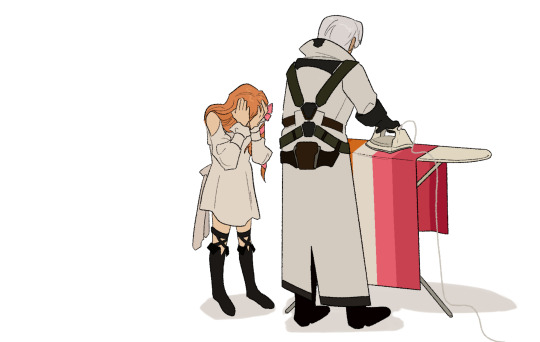
going🚗💨eden raids
#final fantasy xiv#thancred waters#ryne waters#urianger augurelt#gaia ffxiv#andromeda elo#ffxiv#fanart#did verse last night i'm having soooo much fun#'road trip with ryne and her dad and her dad's bf and a goth girl she has a crush on where you get the shit beat out of you repeatedly'#is an impeccable premise
4K notes
·
View notes
Photo

Spider folklore
I saw them in a dream. The spider pattern on the dress is a must
2K notes
·
View notes
Text
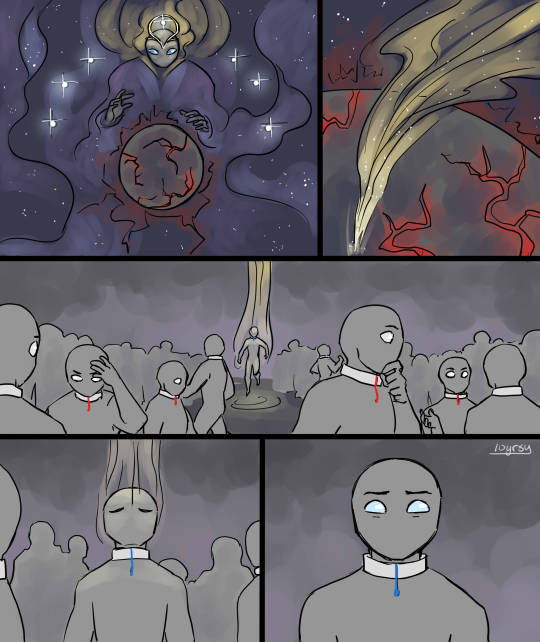
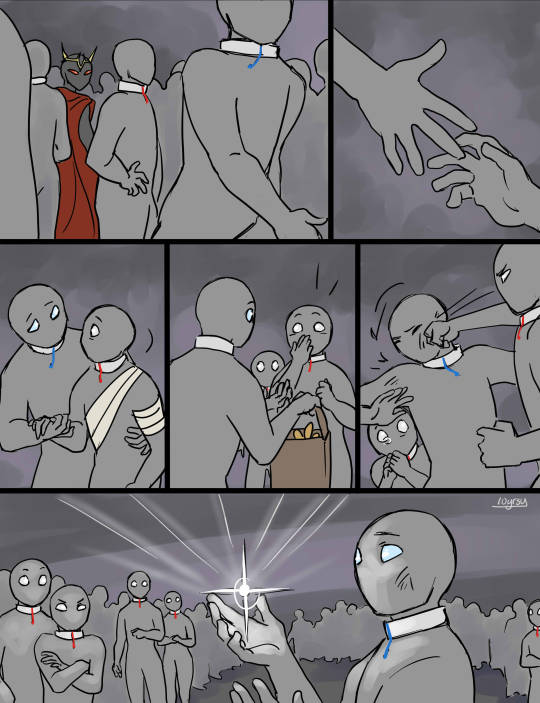
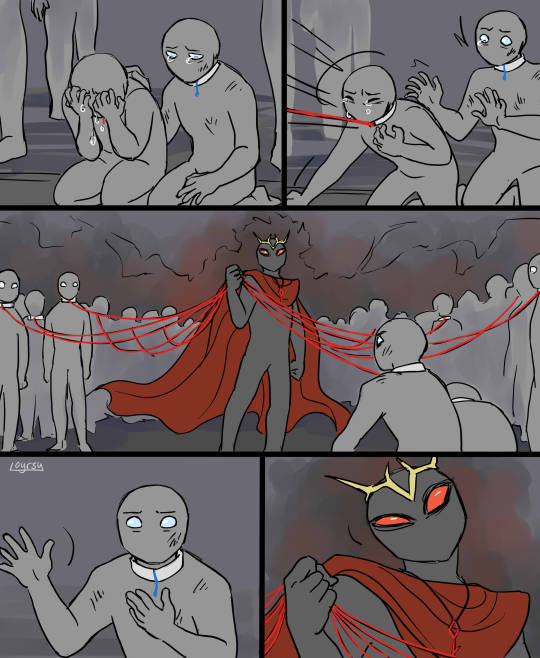
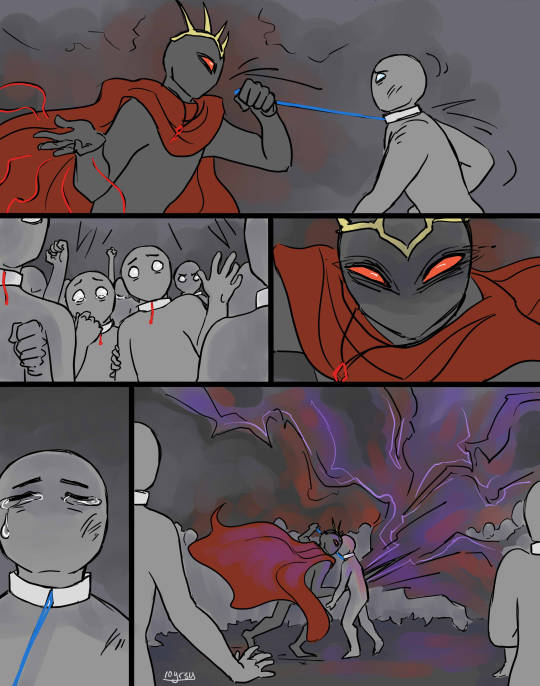
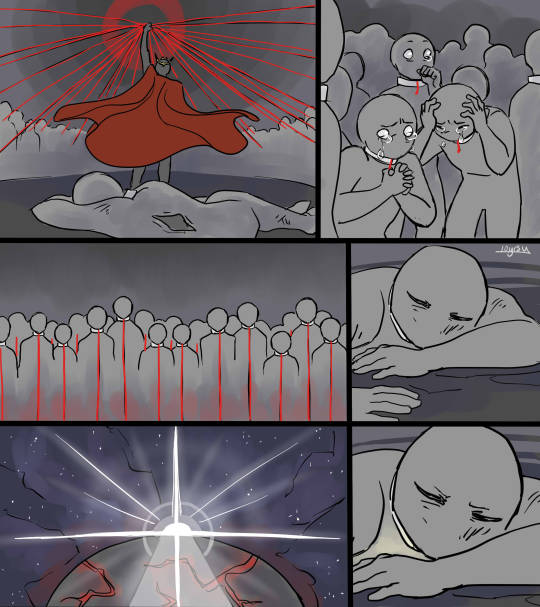
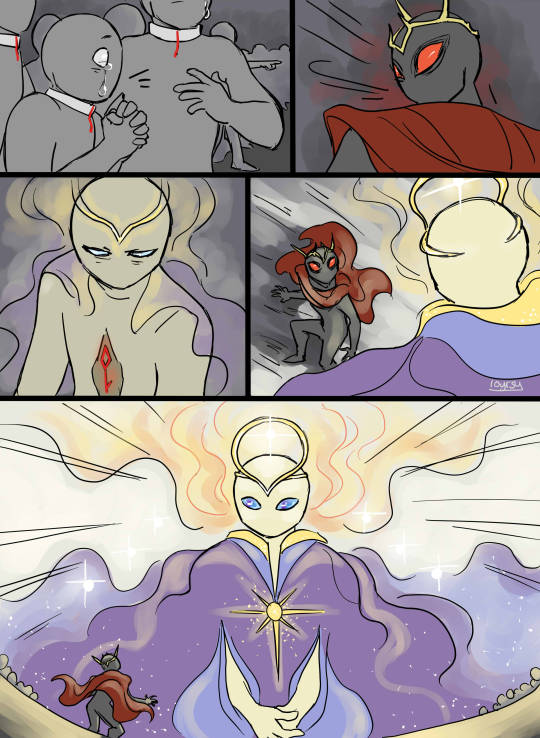
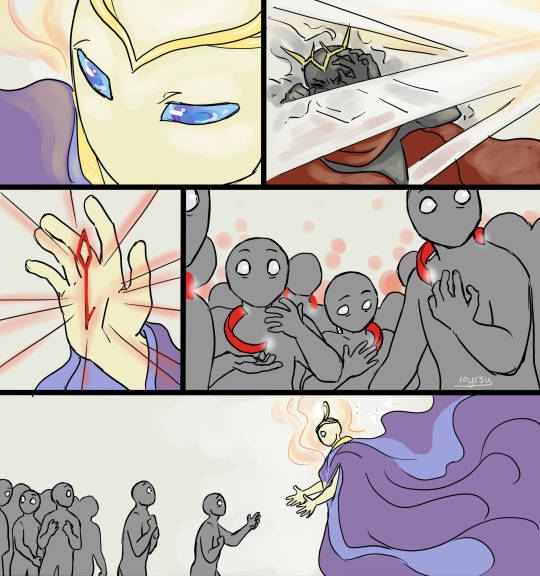
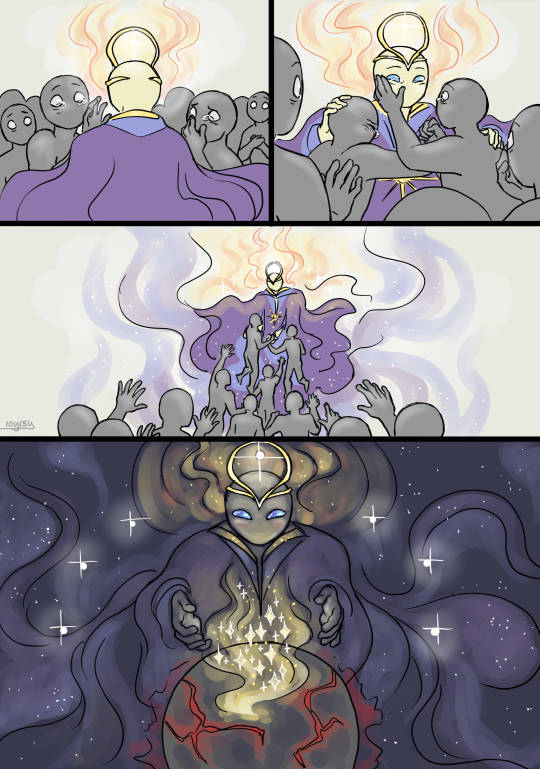
i've been inspired by this song "Knight on the Moon- John Lordwood" recently. there's just something very melancholy about it, but in a mysterious way that builds into these intense moments of battle or rescue or something (the beginning leading up to 2:50 and also 6:27 onward).
this is the story of the Gospel, but i hope it's in a way that makes you see it with fresh eyes. the God of the universe, the vast cosmos, saw our sin and our suffering, and loved us enough to come down Himself. He was born as a human and experienced the joys and sorrows that we experienced. the devil is the temporary ruler on Earth and everyone is born under his rule, whether they know it or not. but Jesus paid the ransom for us, to move us into His own Kingdom. He gave His life so that we could be freed from those chains forever.
every pain you've experienced, every sadness that feels like it will finally swallow you whole; Jesus experienced that personally. He doesn't watch sympathetically from afar, He stands and cries with you, knowing just what you're feeling. He loved you enough to give His very life to give you hope. strength can be found in Him, and freedom, and joy. He is the ONLY way to be saved, not only from the consequences of your sins, but from the doom of living in a fallen world. the fallen world won't last forever though, He will soon remake it new. decide for yourself what kingdom you want to be part of.
"Then, when our dying bodies have been transformed into bodies that will never die, this Scripture will be fulfilled: 'Death is swallowed up in victory. O death, where is your victory? O death, where is your sting?' For sin is the thing that results in death, and the law gives sin its power. But thank God! He gives us victory over sin and death through our Lord Jesus Christ." (1 Corinthians 15:54-57)
youtube
#christianity#God#jesus christ#religion#religious art#faithstuff#faith#salvation#space#heaven#rapture#the gospel#the bible#bible scripture#bible verse#fantasy#stars#comic#digital painting#long comic#long post.#my art#Youtube
834 notes
·
View notes
Text



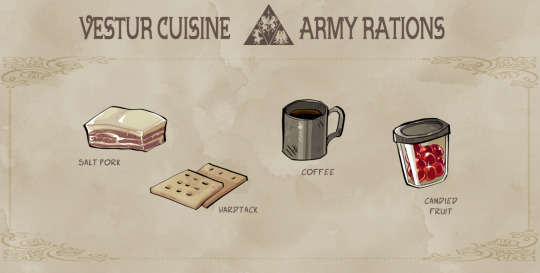
Foods of Vestur
@broncoburro and @chocodile provoked me into doing some illustrated worldbuilding for Forever Gold ( @forevergoldgame ), an endeavor I was happy to undertake. Unbeknownst to me, it would take the better part of a week to draw.
In the process, I conjured about an essay's worth of fantasy food worldbuilding, but I'm going to try and keep things digestible (pardon my pun). Lore under the cut:
The Middle Kingdom
The Middle Kingdom has ample land, and its soil, landscapes, and temperate climate are amenable to growing a variety of crops and raising large quantities of livestock. The Midland palate prefers fresh ingredients with minimal seasoning; if a dish requires a strong taste, a cook is more likely to reach for a sharp cheese than they are to open their spice drawer. Detractors of Middle Kingdom cuisine describe it as bland, but its flavor relies on the quality of its components more than anything.
KEY CROPS: wheat, potatoes, carrots, green beans, apples, pears, and grapes
KEY LIVESTOCK: Midland goats, fowl, and hogs
ROAST FOWL: Cheap and easy to raise, fowl is eaten all over Vestur and by all classes. Roasted whole birds are common throughout, but the Middle Kingdom's approach to preparation is notable for their squeamish insistence on removing the head and neck before roasting, even among poorer families. Fowl is usually roasted on a bed of root vegetables and shallots and served alongside gravy and green beans.
GOAT RIBEYE: Vestur does not have cattle – instead it has a widely diversified array of goats, the most prominent being the Middle Kingdom's own Midland goat. The Midland goat is a huge caprid that fills the same niche as cattle, supplying Vestur with meat and dairy products. Chevon from the Midland goat is tender with a texture much like beef, though it retains a gamier, “goat-ier” taste. It is largely eaten by the wealthy, though the tougher and cheaper cuts can be found in the kitchens of the working class. Either way, it is almost always served with gravy. (You may be sensing a pattern already here. Midlanders love their gravy.)
FETTUCCINE WITH CHEESE: Noodles were brought to the Middle Kingdom through trade with the South and gained popularity as a novel alternative to bread. The pasta of Midland Vestur is largely eaten with butter or cream sauce; tomato or pesto sauces are seldom seen.
CHARCUTERIE WITH WINE: Charcuterie is eaten for the joy of flavors rather than to satiate hunger, and therefore it is mainly eaten by the upper class. It is commonly eaten alongside grape wine, a prestigious alcohol uniquely produced by the Middle Kingdom. The flavor of grape wine is said to be more agreeable than the other wines in Vestur, though Southern pineapple wine has its share of defenders.
BREAD WITH JAM AND PRESERVES, TEA SANDWICHES, & ROSETTE CAKE: Breads and pastries are big in the Middle Kingdom. The Middle Kingdom considers itself the world leader in the art of baking. Compared to its neighbors, the baked goods they make are soft, light, and airy and they are proud of it. Cakes in particular are a point of ego and a minor source of mania among nobility; it is a well-established cultural joke that a Middle Kingdom noble cannot suffer his neighbor serving a bigger, taller cake. The cakes at Middle Kingdom parties can reach nauseatingly wasteful and absurdist heights, and there is no sign of this trend relenting any time soon.
CHOWDER, FARMER'S POT PIE, GRIDDLECAKES, EGGS, CURED MEATS: If you have the means to eat at all in the Middle Kingdom, you are probably eating well. Due to the Midland's agricultural strength, even peasant dishes are dense and filling. Eggs and cured meats are abundant, cheaper, and more shelf stable than fresh cuts and provide reprieve from the unending wheat and dairy in the Midland diet.
STEWED APPLES AND PEARS, JAM AND PRESERVES: The Midland grows a number of different fruits, with apples and pears being the most plentiful. In a good year, there will be more fruit than anyone knows what to do with, and so jams and preserves are widely available. Stewed fruit has also gained popularity, especially since trade with the Southern Kingdom ensures a stable supply of sugar and cinnamon.
NORTHERN KINGDOM - SETTLED
The Northern Kingdom is a harsh and unforgiving land. Historically, its peoples lived a nomadic life, but since the unification of the Tri-Kingdom more and more of the Northern population have opted to live a settled life. The “settled North” leads a hard life trying to make agriculture work on the tundra, but it is possible with the help of green meur. The Northern palate leans heavily on preserved and fermented foods as well as the heat from the native tundra peppers. Outsiders often have a hard time stomaching the salt, tang, and spice of Northern cuisine and it is widely considered “scary.”
KEY CROPS: potatoes, beets, carrots, tundra pepper
KEY LIVESTOCK: wooly goats, hares*
GOAT POT ROAST: Life up north is hard work and there is much to be done in a day. Thus, slow cooked one-pot meals that simmer throughout the day are quite common.
VENISON WITH PICKLES: Game meat appears in Northern dishes about as much as farmed meat – or sometimes even more, depending on the location. Even “classier” Northern dishes will sometimes choose game meat over domesticated, as is the case with the beloved venison with pickles. Cuts of brined venison are spread over a bed of butter-fried potato slices and potent, spicy pickled peppers and onions. The potatoes are meant to cut some of the saltiness of the dish, but... most foreigners just say it tastes like salt, vinegar, and burning.
MINER STEW: While outsiders often have a hard time distinguishing miner stew from the multitude of beet-tinged stews and pot roasts, the taste difference is unmistakable. Miner's stew is a poverty meal consisting of pickles and salt pork and whatever else is might be edible and available. The end result is a sad bowl of scraps that tastes like salt and reeks of vinegar. The popular myth is that the dish got its name because the Northern poor began putting actual rocks in it to fill out the meal, which... probably never happened, but facts aren't going to stop people from repeating punchy myths.
RYE TOAST WITH ONION JAM: Rye is hardier than wheat, and so rye bread is the most common variety in the North. Compared to Midland bread, Northern bread is dense and gritty. It is less likely to be enjoyed on its own than Midland bread, both because of its composition and because there's less to put on it. Unless you've the money to import fruit spreads from further south, you're stuck with Northern jams such as onion or pepper jam. Both have their appreciators, but bear little resemblance to the fruit and berry preserves available elsewhere in Vestur.
HARE DAIRY: Eating hare meat is prohibited in polite society due to its association with the haretouched and heretical nomadic folk religions, but hare dairy is fair game. Hare cheese ranges from black to plum in color, is strangely odorless, and has a pungent flavor akin to a strong blue cheese. It is the least contentious of hare milk products. Hare milk, on the other hand, is mildly toxic. If one is not acclimated to hare milk, drinking it will likely make them “milk sick” and induce vomiting. It is rarely drunk raw, and is instead fermented into an alcoholic drink similar to kumis.
MAPLE HARES AND NOMAD CANDY: Maple syrup is essentially the only local sweetener available in the North, and so it is the primary flavor of every Northern dessert. Simple maple candies are the most common type of sweet, though candied tundra peppers – known as “nomad candy” – is quite popular as well. (Despite its name, nomad candy is an invention of the settled North and was never made by nomads.)
TUNSUKH: Tunsukh is one of the few traditions from the nomadic era still widely (and openly) practiced among Northern nobility. It is a ceremonial dinner meant as a test of strength and endurance between political leaders: a brutally spiced multi-course meal, with each course being more painful than the last. Whoever finishes the dinner with a stoic, tear-streaked face triumphs; anyone who cries out in pain or reaches for a glass of milk admits defeat. “Dessert” consists of a bowl of plain, boiled potatoes. After the onslaught of tunsukh, it is sweeter than any cake.
NORTHERN KINGDOM – NOMADIC NORTH
Although the Old Ways are in decline, the nomadic clans still live in the far North beyond any land worth settling. They travel on hareback across the frozen wasteland seeking “meur fonts” - paradoxical bursts of meur that erupt from the ice and provide momentary reprieve from the harsh environment. The taste of nomad food is not well documented.
KEY CROPS: N/A
KEY LIVESTOCK: hares
PEMMICAN: Nomadic life offers few guarantees. With its caloric density and functionally indefinite “shelf life,” pemmican is about as close as one can get.
SEAL, MOOSE: Meat comprises the vast majority of the nomadic diet and is eaten a variety of ways. Depending on the clan, season, and availability of meur fonts, meat may be cooked, smoked, turned to jerky, or eaten raw. Moose and seal are the most common sources of meat, but each comes with its own challenges. Moose are massive, violent creatures and dangerous to take down even with the aid of hares; seals are slippery to hunt and only live along the coasts.
WANDER FOOD, WANDER STEW: When a green meur font appears, a lush jungle springs forth around it. The heat from red meur fonts may melt ice and create opportunities for fishing where there weren't before. Any food obtained from a font is known as “wander food.” Wander food is both familiar and alien; the nomads have lived by fonts long enough to know what is edible and what is not, but they may not know the common names or preparation methods for the food they find. Fish is simple enough to cook, but produce is less predictable. Meur fonts are temporary, and it's not guaranteed that you'll ever find the same produce twice - there is little room to experiment and learn. As a result, a lot of wander food is simply thrown into a pot and boiled into “wander stew,” an indescribable dish which is different each time.
CENVAVESH: When a haretouched person dies, their hare is gripped with the insatiable compulsion to eat its former companion... therefore, it is only proper to return the favor. Barring injury or illness, a bonded hare will almost always outlive its bonded human, and so the death of one's hare is considered a great tragedy among nomads. The haretouched – and anyone they may invite to join them – sits beside the head of their hare as they consume as much of its rib and organ meat as they can. Meanwhile, the rest of the clan processes the remainder of the hare's carcass so that none of it goes to waste. It is a somber affair that is treated with the same gravity as the passing of a human. Cenvavesh is outlawed as a pagan practice in the settled North.
HARE WINE: While fermented hare's milk is already alcoholic, further fermentation turns it into a vivid hallucinogen. This “hare wine” is used in a number of nomad rituals, most notably during coming of age ceremonies. Allegedly, it bestows its drinker with a hare's intuition and keen sense of direction... of course, truth is difficult to distinguish from fiction when it comes to the Old Ways.
SOUTHERN KINGDOM
The Southern Kingdom is mainly comprised of coast, wetland, and ever-shrinking jungle. While the land is mostly unfit for large-scale agriculture, seafood is plentiful and the hot climate is perfect for exorbitant niche crops. What they can't grow, they obtain easily through trade. Southerners have a reputation for eating anything, as well as stealing dishes from other cultures and “ruining” them with their own interpretations.
KEY CROPS: plantains, sweet potato, pineapple, mango, guava, sugarcane
KEY LIVESTOCK: fowl, marsh hogs, seals
GLAZED EEL WITH FRIED PLANTAINS: A very common configuration for Southern food is a glazed meat paired with a fried vegetable. It almost doesn't matter which meat and which vegetable it is – they love their fried food and they love their sweet and salty sauces in the South. Eel is a culturally beloved meat, much to the shock and confusion of visiting Midlanders.
NARWHAL STEW: Narwhal stew is the South's “anything goes” stew. It does not actually contain narwhal meat, as they are extinct (though the upper class may include dolphin meat as a protein) – instead, the name comes from its traditional status as a “forever soup,” as narwhals are associated with the passage of time in Southern culture. Even in the present day, Southern monasteries tend massive, ever-boiling pots of perpetual stew in order to feed the monks and sybils who live there. Narwhal stew has a clear kelp-based broth and usually contains shellfish. Beyond that, its ingredients are extremely varied. Noodles are a popular but recent addition.
FORAGE: The dish known as “forage” is likewise not foraged, or at least, it hasn't been forage-based in a good hundred years at least. Forage is a lot like poke; it's a little bit of everything thrown into a bowl. Common ingredients include fish (raw or cooked), seaweed, fried noodles, marinated egg, and small quantities of fruit.
HOT POT: Hot pot is extremely popular, across class barriers, in both the South proper and its enclave territories. This is due to its extreme flexibility - if it can be cooked in a vat of boiling broth, it will be. Crustaceans and shellfish are common choices for hot pot in the proper South, along with squid, octopus, mushrooms, and greens.
FLATBREAD: The Southern Kingdom doesn't do much baking. The vast majority of breads are fried, unleavened flatbreads, which are usually eaten alongside soups or as wraps. Wraps come in both savory and sweet varieties; savory wraps are usually stuffed with shredded pork and greens while sweet wraps – which are much more expensive – are filled with fruit and seal cheese.
GRILLED SKEWERS, ROAST SWEET POTATO: While a novel concept for Midlanders and Northerners, street food has long been a part of Southern Kingdom culture. You would be hard pressed to find a Southern market that didn't have at least three vendors pushing grilled or fried something or other. Skewers are the most common and come in countless configurations, but roast sweet potatoes are a close second.
CUT FRUIT AND SEAL CHEESE: Fresh fruit is popular in the South, both local and imported. While delicious on its own, Southerners famously pair it with seal cheese. Which leads me to an important topic of discussion I don't have room for anywhere else...
THE SOUTH AND CHEESE: Since the South doesn't have much in the way of dairy farming, cheese is somewhat rare in their cuisine – but it is present. And important. Cheese is the domain of the Church. Common goat dairy imported from the Middle Kingdom is turned to cheese by monks in Southern monasteries and sold to the Southern public, yes, but as you have noticed there is another cheese prominent in the Southern Kingdom diet: seal cheese. Seal cheese is unlike anything else that has ever been called cheese; the closest it can be compared to is mascarpone. It is is a soft, creamy cheese with a mild flavor and an indulgent fat content. It is used almost exclusively as a dessert, though it is only ever mildly sweetened if at all. It is extremely costly and held in high regard; the most religious Southerners regard it as holy. Dairy seals are a very rare animal and raised exclusively in a small number of Cetolist-Cerostian monasteries, where they are tended and milked by the monks. Due to their status as a holy animal, eating seal meat is forbidden. Eating their cheese and rendering their tallow into soap is fine though.
(HEARTLAND SOUTH) SOUTH-STYLE GOAT: The Heartland South is a Southern enclave territory in the Middle Kingdom. Visiting Midland dignitaries oft wrongly assume that because the Heartland South is in Middle Kingdom territory, Heartland Southerners eat the same food they do exactly as they do. They are horrified to find that familiar sounding dishes like “goat with potatoes” are completely and utterly unrecognizable, drenched in unfamiliar sauces and spices and served alongside fruit they've never eaten. Meanwhile, Heartland Southerners firmly believe that they have fixed the Middle Kingdom's boring food.
(BOREAL SOUTH) “TUNSUKH”: If Midlanders are afraid of Heartland Southern food, Northerners are absolutely furious about cuisine from the Boreal South - the most legendarily offensive being the Boreal South's idea of “tunsukh.” Southerners are no stranger to spice, so when Southern traders began interacting with the North, they liked tunsukh! It's just... they thought it needed a little Southern help to become a real meal, you know? A side of seal cheese soothed the burn and made the meal enjoyable. And because the meal was enjoyable, the portion sizes increased. And plain boiled potatoes? Well, those are a little too plain – creamy mashed sweet potato feels like more of a dessert, doesn't it? ...For some reason, Northerners didn't agree, but that's okay. The Boreal South knows they're just embarrassed they didn't think of pairing seal cheese with tunsukh sooner.
ARMY RATIONS
The food eaten by the King's Army is about what you would expect for late 1700s military; salt pork or salt chevon, hard tack, and coffee. The biggest divergence they have is also one of Vestur's biggest points of pride: they have the means to supply their troops with frivolous luxuries like small tins of candied fruit from the Midland. A love of candied fruit is essentially a Vesturian military proto-meme; proof that they serve the greatest Tri-Kingdom on the planet. Don't get between a military man and his candied fruit unless you want a fight.
#verse: forever gold#worldbuilding#fantasy worldbuilding#food worldbuilding#fantasy food#food art#animal death//#might have to proofread this later forgive any typos I am tired
531 notes
·
View notes
Text

don't ever let go of what's beloved
#ff7#ffvii#ffvii remake#ffvii rebirth#final fantasy 7#final fantasy vii#zack fair#aerith gainsborough#zerith#my art#i forgot i had this#i got to finish this while watching rebirth ending a h a#i'm not crying. not at all#i'm weak @ the star crossed lovers trope#this game... M A N#i didn't think i'd love the remake / rebirth verse so much but here i am#if the drawing is changing let's. pretend you didn't see anything#i'll draw more ff7 stuff bc it's brainrot time
164 notes
·
View notes
Text

Bard Char?
5 notes
·
View notes
Text

“Rowan..that’s where you are.” Trunks said as he simply appeared from out of nowhere. Gone for months, but back again, a little older, wiser and perhaps stronger. “This world of yours is in grave trouble, I’m going to need your help if I’m ever going to stop this world of yours from facing ruin.”
liked for a starter / @knightshonour
#❛ rp ━━ when choices made had forged the blade.#❛ crossover ━━ can't bury the truth the past is far from dead.#verse: fantasy#knightshonour#time shenanigans with trunks
3 notes
·
View notes
Text
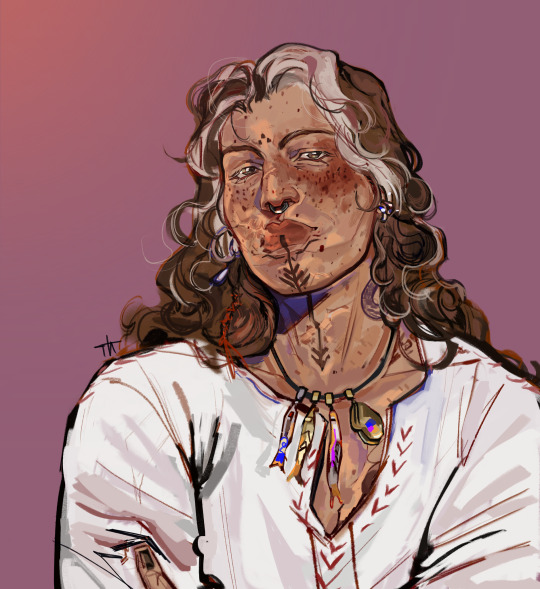
New butch dropped. Definitely not doomed by the narrative
#my art#digital art#artists on tumblr#dnd character#oc:Oscen#I’ve been wanting some dark high fantasy stuff… expect more portraits soon all I can keep thinking about is them. my silly butch#breathless verse#at the edge of God’s tomb
398 notes
·
View notes
Text



Thought it would be fun to illustrate some Amaranthine cuisine from various regions (and time periods). Long writeups under the cut!
Western Kingdom Cuisine: Northern Upper Class
The cultural cuisine of the northern part of the Western Kingdom is shaped by the region's harsh, snowy climate. The cold meant that it was easier to keep food from spoiling, but hard to find it in the first place. During the warmer spring and summer months, food would be collected and then salted, dried, pickled, or otherwise preserved in order to last through the winter. Red meat is their primary dietary staple, and is served in a wide variety of ways, including raw and engastrated. Dairy is also common in all forms -- cheese, butter, milk, and as a component of common sauces and chowders (another cultural favorite, and great way to use up leftovers). Alcohol is also common, with a favorite cultural drink being a spiced, warmed fermented milk with a flavor similar to eggnog.
Northern dishes prioritize making use of all parts of the animal, especially nutrient-rich organ meats and fat. As a landlocked region with few rivers, fish is somewhat uncommon, but not unheard of, especially salted or pickled fish shipped in from the south. Also, as mentioned before, eating animals, including "one's own kind", is not taboo at all in this region. In such harsh climates, turning one's nose up at a filling meal is seen as ridiculous.
When good meat is available, though, presentation can get a little… creative. Or, as some might describe it, obscene. Feasts for nobles often involve whole roast hogs stuffed with turkeys stuffed with game birds stuffed with exotic, imported pickled fish, ground meat sculpted into strange and creative shapes, and other ostentatious displays. If a nobleman's chefs can do something artistic with the meat that his guests have never seen before, it's considered very impressive. Of course, to foreigners, a western kingdom noble's banquet can look rather nightmarish and grotesque. Such displays of excess are generally the realm of the wealthy, but most families will still celebrate with a "turducken" or similar engastrated roast once a year during winter feast.
Fresh fruits and vegetables make up only a small component of northern dishes. Berry preserves and pickled vegetables are prepared during the summer months, but the only "fresh" vegetables accessible during colder months are hardy root vegetables and tubers harvested from geothermal caves. Mushrooms, also harvested from the caves, are eaten in many forms.
Bread made in this region is typically very hard and dense. This "thickbread" is intended to be soaked in gravy, milk, or soup to soften it and make it more palatable. Attempting to eat the bread without softening it is a clear indicator that someone is a foreigner, or perhaps so poor that they can't afford a proper meal. Some "thinbread" is baked slightly softer and intended to be eaten in slices, but culturally, it's still expected that you put some sort of gravy or spread on it so that you don't look like a confused foreigner or destitute peasant.
For dessert, northerners often eat dessert breads soaked in sweetened, spiced cream and topped with berry preserves and candied mushrooms. Berry tarts are also made with preserves during colder months and fresh fruit during summer months, and are associated with spring, celebration, and hardship ending. These berry tarts are often eaten at celebratory dinners at the end of winter and given to students after finishing exams.
Many residents of other territories find traditional northerner food a little overwhelming due to how rich and dense it is. It can certainly take some getting used to. Eastern Kingdom residents tend to find northern cuisine especially nightmarishly grotesque and barbaric due to their cultural views around meat. However, with increased trade and travel over the last few decades, northerner food is beginning to look more like the food from the rest of the Western Kingdom, and some of the more offputting cultural practices like the ostentatious engastrated meatcraft and inedible-unless-softened bread are becoming somewhat less popular.
Eastern Kingdom Cuisine: Coastal Citydweller
The Eastern Kingdom's cuisine is similarly influenced by their climate. The desert that spans much of the region meant that, aside from its sparkling oasis cities and rim of fishing towns along the coast and major river, many residents traditionally lived a nomadic lifestyle. Additionally, unlike the Western Kingdom, they absolutely do view "eating your own kind" as tantamount to cannibalism, which meant that most red meat was only consumed during times of desperation or occasionally during holidays/rituals, though the latter is mostly seen as a weird unsavory rural thing.
The Eastern Kingdom's meat taboo generally does not extend to fish, shellfish, and insects. Fresh fish and shellfish are routinely consumed near the coast, often seared in olive oil and spices and served over a couscous-like grain base, and a salty paste made of fermented fish is smeared on bread in interior regions. Beetles coated in chopped nuts and chili powder and dried, and honeyed crickets are also popular snacks.
Eastern Kingdom cuisine also involves a lot of nuts, beans, and seeds as major dietary staples. These foods are long-lasting, spoilage-resistant, nutrient-rich, and grew easily along the banks of the kingdom's major waterway and oases even before cities settled there. These three food groups are found in nearly all of their cooking. Nuts and seeds are baked into bread and desserts but also mixed into stir fry-type dishes to add protein. A common dessert and trail snack consists of dried dates mixed with walnuts. Dates and figs are also made into jams and eaten spread over bread or as a component in sauces.
Vegetables and fruits, as well as olives, were grown in grand, sprawling, aqueduct-fed gardens in oasis cities and on riverbanks. Cacti, once cultivated extensively by ancient nomads, are served chopped and glazed with honey, another dietary staple.
Dairy, derived from pack animals used by nomads, is also somewhat common, though difficult to transport without spoilage. It is paradoxically seen as a practical, basic food by nomads and farmers, who can milk it directly from its source, something of a luxury by city-dwellers.
Additionally, the Eastern Kingdom's sprawling coastlines mean an extensive seafaring presence. As a result, they have brought back many novel plants from far afield to be cultivated in the Eastern Sultan's personal palace garden. Among these: cocoa beans, which are refined into a spicy energizing herbal drink similar to coffee. "Chocolate houses" serving this drink can be found throughout larger cites, sometimes mixing the cocoa drink with more familiar sweetened cactus juice to stretch the expensive cocoa powder further.
Post-Fall Cuisine: Ironfrost Middle Class
The society that eventually emerged after the fall of the Old Kingdoms was quite different from what came before. Though discovery of ironworking led to the rise of industrialization--processed food and automated canning, among other innovations-- the harsh, permanent winter that eventually consumed most of the continent meant that cuisine never reached the levels of decadence it had in the Old Kingdoms. This is especially true of the working class in Ironfrost, whose rather dreary cuisine is shown here.
Limited accessibility of fresh fruits and vegetables--grown in engineered greenhouses or shipped in from the far south over increasingly long distances as the cold spread southward--meant that nearly all vegetables are eaten canned. Many, especially those in rural northern towns that lacked greenhouses, may have never even seen a fresh tomato or head of lettuce before. (The City of the Sun produces fresh fruit and vegetables for the far north--including exotic apples in nigh-extinct Old Kingdom varieties--but cutting a trade deal with the reclusive city-state can be difficult due to the whims of its elusive cultish leader.)
The one exception? Mushrooms. Like the Western Kingdom northerners that lived there before them, Post-Fall societies came to rely heavily on harvesting edible mushrooms from the geothermal caves below the tundra. Mushrooms are a crucial dietary staple and can be roasted, pickled, fried, pureed, or even candied. Many of the more specialized cooking styles such as candying were passed down by survivors of the fallen Western Kingdom, thought the passage of time and changing availability of spices and other ingredients have rendered many recipes quite different from their ancestors.
Fresh meat is easier to access and easier to preserve with minimal loss of taste or texture thanks to the frigid weather providing easy "refrigeration" by way of outdoor iceboxes. However, a whole, freshly-cooked roast is still considered a rare treat for most, especially for the mine and factory workers living within the dense industrial labyrinths of Ironfrost. Canned and dried meats are popular due to being less sensitive to spoilage when kept indoors or transported across different climates.
Overall, the heavy reliance on dried and canned food means that most available ingredients are ugly, mushy, and lacking in natural taste due to the extensive preservation process. As a result, stews, loafs, and casseroles are common, as well as jellied aspic dishes. Any manner of preparation that can hide the appearance of limp, shriveled vegetables or disguise the taste of eating the same salted meat every day is useful. Creative meat presentation, such as sculpting ground meat into fun shapes, decorated meatloaf, and ornate aspic molds is another cultural holdover passed on by Western Kingdom survivors, though in the current day it's associated more with the middle or lower middle class rather than nobility. It is now more of a way to make the most out of poor circumstances than to impress fellow nobles at parties.
(Side note, not pictured: Modern day Ironfrost elite tend to favor very plain dishes made out of fresh food, garnished with sliced fruit--the mere fact that they can access such exotic fare makes their wealth self-evident! An aspiring elite with limited funds can choose to rent a bowl of Sun City apples or even an elusive pineapple to impress party guests instead.)
One of the few pieces of Eastern Kingdom food culture that survived to the present day is chocolate, though like Western Kingdom dishes, it is now quite different from its original form. These days, cocoa is blended with fat and sugar and eaten as a dessert: chocolate. This has caused its popularity to explode. Chocolate bars are incredibly popular for their delicious taste and portability, and cakes and cookies made with chocolate are coveted by the poor and wealthy alike. Of course, the cold climate means that cocoa beans can only be grown in specialized greenhouses, and the owners of these greenhouses are keen to charge a premium for access. Ironfrost and The City of the Sun are the two major cocoa producers and it's not unheard of for Ironfrost soldiers to bully smaller cocoa growers out of business to maintain their near-monopoly. Still, hidden cocoa grows scattered around the tundra ensure that a large supply of "bootleg" chocolate remains on the menu--just don't get caught with it in Ironfrost territory.
285 notes
·
View notes
Text







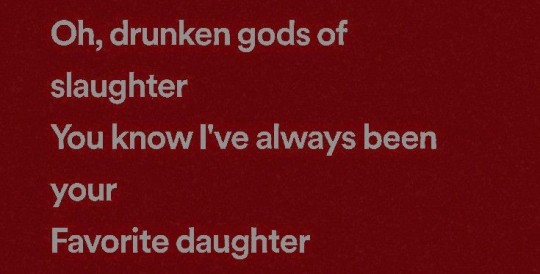
In the shadows of my love, a haunting truth lingers – my boundless affection, a curse veiled in desire. I dread the certainty of my impending ruin upon you, yet, entangled in selfishness, I refuse to release the grip of this heart that claws at your soul. You, dear one, unwittingly embody my twisted salvation.
✙✙✙✙✙✙✙✙✙✙✙✙✙✙✙✙✙✙✙✙✙✙✙✙✙✙✙✙✙✙✙✙
#riri verses🖋#dark poetry#parasitic love#dark academia aesthetic#dark academic aesthetic#dark academia#dark academism#dark romance#poetry#dark poet#gothic poetry#dark literature#gothic#goth aesthetic#writers and poets#poems and quotes#dark fantasy#dark romanticism#dark romantica#pictures source: pinterest#web weaving#web weave#theme: a love that destroys everything#a love that's too violent#some call it obsession; some call it mental illness#yandere#yandere themes
162 notes
·
View notes
Text
thinking about kristen applebees worshiping a goddess of mystery, doubt and the unknown, and what it says about the fact that that faith did not spread during four months of endless night from the night yorb.
thinking about how the world watched as this prophet of multiple gods said “what is your name, you who i praise” and brought cassandra back from the nightmare king.
thinking about what it would take to say, “i know you are afraid and uncertain. i cannot offer you answers, only respite, and the knowledge that you are not alone in the night. the void is vast, but there is something there to seek out.”
thinking about how galicaea benefited not only from tracker’s trip to fallinel, but from having answers in the light of the moon amidst the endless night. about how sol and helio must have felt a loss of faith in the absence of the sun.
thinking about kristen applebees, who tried to pray for years on end to find a reason for why bad things happen to good people, and upon finding a process, felt the paralysis of the unknown.
#dimension 20#dimension 20 spoilers#kristen applebees#saint kristen applebees#d20 cassandra#d20 galicaea#d20 helio#d20 sol#fantasy high junior year#fantasy high#fhjy#fhjy spoilers#d20 prose & verse
705 notes
·
View notes